Features - December 15, 1999
A Grief Observed
Since the 1983 downing of Korean Airlines flight 007, in which John Oldham
'79 and 268 others perished, mystery lingers and grief abides for Oldham's
family.
by Dan White '65
 On the evening of august 31, 1983, John Oldham '79 boarded a Korean
Airliner to begin the first leg of a journey to China. A recent graduate
of Columbia law school who aspired to a career in international affairs,
he planned to spend a year studying Chinese language and culture at the
University of Beijing. He had intended to leave a day earlier, but, at the
last minute, had delayed his departure by 24 hours to help some Chinese
students find housing in New York City.
On the evening of august 31, 1983, John Oldham '79 boarded a Korean
Airliner to begin the first leg of a journey to China. A recent graduate
of Columbia law school who aspired to a career in international affairs,
he planned to spend a year studying Chinese language and culture at the
University of Beijing. He had intended to leave a day earlier, but, at the
last minute, had delayed his departure by 24 hours to help some Chinese
students find housing in New York City.
Dressed in his normal attire of rumpled pants and rumpled shirt, he settled
into his seat in row 31. He had a large head, broad shoulders, and big feet-his
size 11 sneakers were spattered with cream white paint. In a typical burst
of manic energy he had painted his family home in suburban Washington, D.C.,
just before leaving.
Most of the other passengers were Asians. They included a number of families
with small children. He remembered when his own family-his parents and four
siblings-had traveled by plane to Taiwan. They had lived there for several
years during the Vietnam War in the late '60s while his father, a urological
surgeon, had served as chief adviser to the South Vietnamese Ministry of
Health. The experiences had nurtured in John a passion for Asian culture.
Between Princeton and law school, he had lived in Hong Kong on a Fulbright.
He knew Taiwanese and Mandarin. From his law school digs near St. John's
Cathedral in New York City, he had roamed far and wide to find the best
Chinese restaurants. Asian women fascinated him, and the love of his life
at Princeton had been Korean.
His buoyant spirit had been tested by the death of his younger brother,
Ben, from a brain tumor at age 17. (John had taken off part of his senior
year at Andover to help care for him.) And by his parents' divorce; after
Vietnam, his father had never been able to reintegrate into family life.
John worried about his mother, Nan Oldham. He knew she thought of him
as her "pal," her chief confidante. When she visited him at law
school, they took long walks in Central Park. Her body had absorbed so much
pain and grief that she had never fully recovered her confidence and stamina.
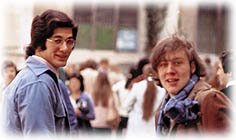 His youngest sister, Charlotte, had become angry and rebellious in high
school and had refused to apply to college. She was bright and talented,
and John had filled out college applications for her and made her sign them.
She had been accepted at Wesleyan. His mother was taking her there this
week for freshman orientation. His mother had probably passed John on the
New Jersey Turnpike on her return, not knowing her son had delayed his departure
a day. Charlotte was a work in progress. A year was a long time for him
to be so far away.
His youngest sister, Charlotte, had become angry and rebellious in high
school and had refused to apply to college. She was bright and talented,
and John had filled out college applications for her and made her sign them.
She had been accepted at Wesleyan. His mother was taking her there this
week for freshman orientation. His mother had probably passed John on the
New Jersey Turnpike on her return, not knowing her son had delayed his departure
a day. Charlotte was a work in progress. A year was a long time for him
to be so far away.
John felt pressure to begin earning a regular income. In college and
law school, he had sometimes worked four jobs at once. A lucrative offer
from an international law firm in Washington, D.C., had strongly tempted
him. His Princeton friends were getting on with their careers, but it was
too hard to pass up a year in China. He saw it as a unique opportunity to
figure out some grand scale on which he might help people less fortunate
than he.
The captain of the airplane was describing their route. They would fly
first to Anchorage to refuel. They would then travel southwest across the
top of the North Pacific Ocean on an arc that traced the Aleutian Islands
below. Known as Romeo-20, the route was one of five parallel, 50-mile-wide
corridors for air traffic between Alaska and Asia, the same route John had
flown before. Just west of Romeo-20, the Soviet Union began, and seemed
to extend forever.
Shortly after midnight, the Boeing 747 200-B jumbo jet took off and climbed
through cloud cover over Long Island. Turning northeast, the jetliner aimed
toward Anchorage, seven hours and 3,400 miles distant. Seoul was another
eight hours' journey. John reclined his chair and slept, refreshing himself
for his new adventure, with its boundless prospects for learning about China,
and about its food, and about fascinating Asian women.
Nan Oldham listened to the radio as she drove to work the next morning,
August 31, at the Naval Air Systems Command, where she served as an analyst
on technical projects. She heard a news report that a Korean Airliner was
missing en route to Seoul. She had acquired a certain savvy about the goings-on
of governments, and her immediate reaction was, "Well, look what we've
done."
One of her colleagues asked nervously about John. She explained that
he had flown a day earlier, but as she spoke, she realized she didn't know
exactly where her son was. She called KAL, but could get no information.
She tried a friend at the State Department. Further reports were sketchy
and confusing: the plane had flown over Soviet airspace and been forced
down on Sakhalin Island, a Soviet outpost in the Sea of Japan. All passengers
were safe and a U.S. submarine was speeding to the rescue.
The next morning, September 1, Secretary of State George P. Shultz '42
announced that Korean Air Lines Flight 007 had strayed off course into Soviet
airspace and been shot down by a missile fired from a Soviet jet. All passengers
were presumed lost. Nan Oldham had already discovered that the list of 269
victims to appear the next day in The New York Times would include Oldham,
John, Mr.
People from other airline disasters contact me constantly," says
Nan Oldham, who now lives in an apartment in north west Washington, D.C.
She has a collection of books and papers about the shoot-down of the plane,
their key points marked by paper clips and old postcards. By coincidence,
the date is September 1, the 16th anniversary of the tragedy. Her daughter,
Charlotte, who lives with her husband in nearby northern Virginia, and who
advises Senator Paul Wellstone on international relations, has called to
remind her that they would normally go to church that day in memory of John.
"There's the annual international air disaster conference in Detroit
this fall. I'm not going, but here's the list of attendees," Nan says,
displaying several pages of names and addresses with their respective air
disasters in parentheses. "A father from Canada who lost a daughter
who had just graduated from college used to call me several times a year.
I used to go to see a woman in Cincinnati whose husband was killed on the
way to take care of his ailing mother. She was left with two babies. I used
to meet with families of victims, as part of a support group, but I don't
any more. Did you see The Washington Post this morning-there's been a plane
crash in Argentina. Every plane crash always makes me feel terrible all
over again."
Her hair is pulled neatly back. Her southern drawl is from her girlhood
on a horse farm in Lexington, Kentucky. When words and facts elude her from
time to time, her easy, warm smile fades to a look of anguish, and she suddenly
seems wearied by the process of trying to remember. "I don't look at
John's belongings, but I keep them," she says. "There's no getting
over losing a child. You lose a part of you. Christmas is an especially
hard time-Ben died in December, and John was born on December 28.
 "You never forget any of your children. But you have to go on.
I have a lot of friends, and I make it a point to socialize every day. I
spend holidays with Charlotte, my oldest daughter, Nancy, and her family
in Texas, and my oldest son, Bill, who's a New York City police officer.
He suffered terribly-I think he would have gone to law school if it hadn't
been for John's death. I still hear from some of John's Andover and Princeton
friends.
"You never forget any of your children. But you have to go on.
I have a lot of friends, and I make it a point to socialize every day. I
spend holidays with Charlotte, my oldest daughter, Nancy, and her family
in Texas, and my oldest son, Bill, who's a New York City police officer.
He suffered terribly-I think he would have gone to law school if it hadn't
been for John's death. I still hear from some of John's Andover and Princeton
friends.
"So many questions have never been answered," she continues,
opening one of the books to a marker. "The U.S. said the plane had
flown off course. I've flown out of Anchorage plenty of times-how could
they lose the plane? Nobody could have lost that plane. I wish I could believe
the straying off course was an accident."
From the start, discrepancies arose in accounts of the plane's flight
path, and why U.S. and Japanese air controllers hadn't warned the errant
plane. Aspersions turned sinister with reports that the pilot had told his
wife the flight was going to be unusually dangerous, and she should buy
more life insurance. Why had he ordered an extra 10,000 pounds of fuel in
Anchorage? The plane's several turns suggested a deliberate attempt to fly
into Soviet territory. And the aircraft had reported its position inaccurately,
as if trying to be evasive. Why had the pilot ignored the Soviet warning
shots? And why did tapes of communications between air controllers given
to the U.S. Government before their public release contain erasures?
In an effort to build support for a congressional investigation, Nan
Oldham appeared on The Phil Donahue Show and other talk programs. "I
raised a lot of hell," she says. "I never asserted anything directly,
never talked like I am now." She sold the movie rights to television
in hopes that a dramatic re-creation would generate further interest.
"My theory," she says, "is that our government provoked
an incident to make the Soviets look like the evil empire that Reagan was
always describing. He needed to sell our defense agenda, to get missiles
placed in Germany, where there was a lot of opposition to us at the time.
Otherwise, how could this have happened? There was no effort to find the
black box because, we were told, it was inside Russian waters. I know Ben
died because of a tumor, but to think my own country sacrificed my son.
. . . " In the end, Congress declined to conduct an investigation,
though the controversy continued, producing several books and articles in
subsequent years.
We live in an age when the media bombard us with reports of how people
are coping with the loss of loved ones struck down before their time-witness
the Littleton, Colorado, shootings and the Kennedy plane crash this past
summer. The coverage almost always focuses on the short-term effects of
grief, implying that people suffer terribly for awhile and then there is
some kind of closure which enables them to resume a mostly normal life.
When the downed Kennedy plane was finally located in the ocean, one newspaper
headline read closure. The reality is much more complex, especially in cases
where closure is delayed, or blocked altogether, sometimes permanently.
"I see in my mother a deep maternal rage about the loss of her son,"
says Charlotte. "She has been profoundly damaged. Parents can never
completely heal from the loss of a child. The loss of two is unfathomable-it's
the horrific overlaid with the anger of not knowing what really happened.
She never had a body to bury, never got answers. She feels she's been mistreated,
lied to. The U.S. Government has never been forthcoming.
"I believe Reagan knew the plane was off course," Charlotte
continues, "and chose not to warn it because it would activate the
new system of Soviet radar which our military wanted to observe. It was
said later that we got a treasure trove of information from the incident.
My mother's anger is a powerful force. It keeps us alive, though it's very
disturbing to others."
At wesleyan, the chaplain had come to Charlotte's room to tell her the
grim news. Two days later, she and Bill flew to Korea to retrieve John's
body. "We took a little ferry that meandered out to the crash site,"
she recalls, "just off Sakhalin. It was surreal: this bizarre outpost
of the Soviet empire which was a dumping place for criminals; there were
fishing trawlers and warships and Buddhists throwing chrysanthemums into
the water, and Soviet fighters buzzing us. We saw things floating-a baseball
glove, but no bodies. Then the tide shifted, and body parts began to wash
up." They came home without his body and terribly confused about what
had actually happened.
As the controversy intensified, news of John's death spread among his
network of Princeton friends. Marianne Eisman '79 *90 saw the passenger
list in the newspaper. Her father drove her around while she wept. She had
always gone to John for help on a problem, or a reassuring hug. He helped
type her thesis and somehow produced a key to the Woodrow Wilson School
so she could hide away to study late at night. "He was there and suddenly
he disappeared," she remembers from her home in New Jersey, where she
lives now with her husband. Since her days in the English program, she has
been an editor and consultant.
"After his death, I dreamed of planes falling from the sky,"
she continues. "It's still my nightmare of how to die. A former student
of mine was killed in the TWA crash, and the Kennedy plane crash this summer
really hit me. John Oldham's death was a real loss of innocence. I have
never again been surprised by grief or cruelty. His death and those of the
268 others are still chilling to me. I didn't want to believe the U.S. put
the plane there as a test. But I know governments do that-I deliberately
have not read those books. John was dead. The reasons mattered less than
his absence."
"We became especially close after Princeton when I was in residency
at Columbia," says former roommate Seth Lederman '79, a research immunologist
and professor at Columbia medical school who is married and has three children.
"We often had intense discussions about world problems. He had lots
of foster brothers and sisters-war orphans. When he talked, every part of
his body moved, as if he were a tornado that had settled near you and then
moved on. His death devastated me-we'd held a goodbye party for him just
before he left. I couldn't imagine him being gone forever. A number of us
talked about him at our 20th reunion last June. At 27 he was bigger than
life. How tragic an early death is. Today, all the people have moved on,
done something with their lives. In reality, he was a law student, cut down
at 27."
David Michaelis '79, another roommate, "felt routed by his death.
He was someone I loved automatically from Freshman Week on," he says.
"He had a kind of pop-eyed look with a huge grin, a wild surmise. He
was a force of nature who went right for the throat, the gut, the whole
of it-he was the most absolute person I knew. He'd see a woman across the
courtyard, someone he knew just slightly, Sarah Blodget '79, for instance.
He would call out to her, 'Babe Blodget, with your eyes of blue, how you
warm my heart when the wind blows through.' It was totally off the wall,
Shakespearean, madly persuasive.
"John worked in the Pub, and it was like him to carry drunken students
on his shoulders back to their rooms. He worked in Food Services all four
years and got to know everyone. Every week, he'd buy single red roses for
the women.
"I went to his memorial service at Columbia. Everyone was weeping,
and I had a strong sense that this must be like war with so many people
in my life dying," Michaelis continues. "My mother had died in
1981, and I was still grieving for her. Then John's death happened-people
were just leaving, abandoning me. His death added to an unresolvable sadness
which revealed in me an inability to grow up. The year 1983 was a turning
point in my life. I got more serious about my work." Michaelis, who
wrote about John in the October 5, 1983, issue of paw, lives in Washington,
D.C., with his wife and children, and works as a writer.
"The endlessness of the conjecturing about what happened added to
my sense of desperation about the world," Michaelis adds. "I think
about him all the time. Every time I get on a plane, especially long flights
over water, I return to his death, to the horror of what he must have experienced."
"By the time of the memorial service," says Chris Baumer '80,
another roommate, "speculation was rabid about what had actually happened.
I was sitting there listening to the minister rail against the Soviets,
thinking, 'How does this affect me? My friend has gotten blown up.' "
Baumer is a public relations consultant who lives on a 90-acre farm outside
Charlottesville, Virginia, with his wife and young children. "When
I get discouraged about something, begin to think it's all for naught, I
remind myself, 'That's not how John would have thought.' "
Elizabeth Pedersen '82 had long red hair that John liked to pull. One
of her best friends, he constantly chided her about smoking. "He believed
people could improve, and he didn't exclude himself from that," she
says, having recently moved to Virginia from Japan, with her husband and
a brood of children ranging from three months to 14 years. "When he
died, I quit smoking in honor of him."
John's girlfriend at Princeton, Elisabeth Choi '78, now an investment
manager living in Boston with her husband and two children, saw John just
a couple of days before he left. "His own losses seemed to have given
him an awareness of the difficulty and fragility of life, beyond his years.
Because of this, he was a great caregiver. I was so overcome by his death,
I didn't know how to handle the controversy. I couldn't fathom it then.
I'd like to think it was human error. I can't deal with the other possibilities.
But I could be naive. I keep in touch with Bill, who reminds me of John."
"I'm still grieving," says Charlotte, who is expecting her
first child next March. "John was such an enormous human. His death
changed me on so many levels. I can't watch the news or films with violence.
I have such low tolerance for it, as if that membrane popped for me. We
clamor for power and recognition, but in the end it's people who count.
It's good to be present in the moment as much as possible and not get sucked
up in a manic lifestyle. John was joyful, but he never got that contentment
that comes with maturity. I've become happier as I've grown older-he was
cut down too early.
"Whenever I'm in New York, I try to attend service at St. John's
Cathedral, in his old neighborhood. When I'm at the ocean I think of him.
His body is there in the ocean and I feel surrounded by him. A few weeks
after the plane went down, we saw photos of his shoes in a magazine. We
followed up through KAL and a few weeks later, a package arrived. His shoes
were inside: size 11 sneakers, spattered with cream white paint. They'd
washed up on a beach in Japan."
Dan White '65, former director of the Alumni Council, is a consultant
in alumni relations and a freelance writer.
Princeton's All-Century Team 1900-99
In the spirit of millennial reflections the Princeton Football Association
(PFA) has come up with an "All-Century" football team-the best
players to wear Princeton orange and black since 1900.
PFA President Stas Maliszewski '66 calls the task of choosing the team
"exciting but exceedingly daunting," for during this 100-year
period the Tigers produced 58 All-Americas while chalking up 12 undefeated
seasons and eight national titles.
Complicating the selection was football's evolution-the game as it was
played early in the century with its mass formations, drop-kicking, and
lack of passing would be hardly recognizable to fans today. The problem
of comparing players from different eras is compounded by Princeton's long
adherence to the single wing, a formation it did not abandon until 1969.
To make the cut, says Maliszewski, "individuals had to demonstrate
a dominance of their position in their era and achieve extraordinary recognition
on team, league, regional, and national levels."
The 10-person selection committee, made up mainly of former players and
coaches, was headed by Thacher Longstreth '41, a former All-America end
who holds the attendance record for consecutive Princeton games (he hasn't
missed one since the Yale contest of 1949).
Captain : Art Lane '34
Coach: Bill Roper '02
Managers : Ben Jones '27, Dick Jones '61
Trainer: Eddie Zanfrini h'42:
Team Physician: Harry McPhee p'46 p'53
Athletic Director : Ken Fairman '34
Equipment Manager: Hank Towns
Sports Information Director: Bill Stryker '50
OFFENSE

Line
Jim Cooney '07
|

Line
Harold Ballin '15
|

Line
Stan Keck '21
|

Line
Charles Ceppi '34
|

Line
Jac Weller '36
|
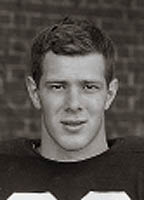
End
Frank McPhee '53
|

Wide Receiver
Derek Graham '85
|
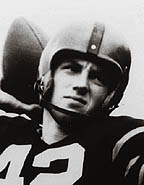
Tailback
Dick Kazmaier '52
|

BACK
Cosmo Iacavazzi '65
|
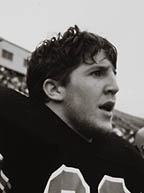
BACK
Keith Elias '94
|

Blocking BACK
George Chandler '51
|

QuarterBACK
Doug Butler '86
|

Kick Returner
Hobey Baker '14
|

Placekicker
Charlie Gogolak '66
|
|
|
DEFENSE

Line
John DeWitt '04
|

Line
Lou Wister '08
|

Line
Ed Hart '12
|

Line
Hollie Donan '51
|

Linebacker
Jim McCormick '08
|
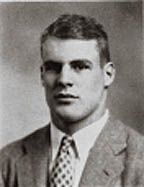
Linebacker
Reddy Finney '51
|

Linebacker
Stas Maliszewski '66
|

Back
Donold Lourie '22
|

Back
Frank Murrey '22
|

Back
Bob Peters '42
|

Back
George Sella '50
|

Punter
Matt Evans '99
|
| |
|
|
|
Other selections of the century:
Top scholar-athlete: Josh Billings '33
Team: 1933
Season: 1903
Overachievers: 1922 Team of Destiny
Greatest football class: 1936 "Pride of Nassau"
Game: 1922 against Chicago, won by Princeton 21-18
Yale game: 1964, 35-14
Upset: 1946 Penn, 17-14
Comeback: 1981 against Yale, 35-31
Worst conditions: 1950 Dartmouth "Hurricane Game"
Toughest opponent: Notre Dame's "Four Horsemen" team of 1924,
which beat Princeton 12-0
Palmer Stadium Play: San White '12's 95-yard winning touchdown run in
1911 against Harvard
Weirdest play: 12th man, in the 1935 Dartmouth "snow game,"
when a drunken Big Green fan stumbled onto the field to tackle a Princeton
player
Biggest shocker in Princeton's favor: 1969 Dartmouth game, 35-7
Biggest shocker against Princeton: 1919 West Virginia game, 0-25
Greatest innovation: Fritz Crisler h'22's design of the "Tiger helmet"
Worst trauma: Abandonment of the single wing
Biggest secret: Knute Rockne's acceptance of the Tiger coaching job in
1931 (he later withdrew)
PFA President: Tom Wilson '13
Yale killer: Royce Flippin '56
Freshman mentor: Harland "Pink" Baker '22
Holdout: Harold Ballin '15, the last Tiger to play without a helmet
Pros: Carl Barisich '73, Karl Chandler '74, Jason Garrett '89
Poet: Paul Muldoon
Poem: Muldoon's "All the Way," written to commemorate the opening
of Princeton University Stadium in September 1998
Song: "The Princeton Cannon Song," by J. F. Hewitt '07 &
A. H. Osborn '07
Tiger mascot: Freddie Fox '39 (male), Blanche Rainwater '95 (female)
Fan, alumnus: Walter L. Morgan '20
Fan, faculty: Christian Gauss
Coaches' pest: F. Scott Fitzgerald '17
Longest attendance streak: All games, Thatcher Longstreth '41, 1949 to
present; Yale game, Bill Bours '39, 1928 to present
For further details, see the PFA's Website (www.princeton.edu/football).
GO TO
the Table of Contents of the current issue
GO TO
PAW's home page
paw@princeton.edu
 On the evening of august 31, 1983, John Oldham '79 boarded a Korean
Airliner to begin the first leg of a journey to China. A recent graduate
of Columbia law school who aspired to a career in international affairs,
he planned to spend a year studying Chinese language and culture at the
University of Beijing. He had intended to leave a day earlier, but, at the
last minute, had delayed his departure by 24 hours to help some Chinese
students find housing in New York City.
On the evening of august 31, 1983, John Oldham '79 boarded a Korean
Airliner to begin the first leg of a journey to China. A recent graduate
of Columbia law school who aspired to a career in international affairs,
he planned to spend a year studying Chinese language and culture at the
University of Beijing. He had intended to leave a day earlier, but, at the
last minute, had delayed his departure by 24 hours to help some Chinese
students find housing in New York City. His youngest sister, Charlotte, had become angry and rebellious in high
school and had refused to apply to college. She was bright and talented,
and John had filled out college applications for her and made her sign them.
She had been accepted at Wesleyan. His mother was taking her there this
week for freshman orientation. His mother had probably passed John on the
New Jersey Turnpike on her return, not knowing her son had delayed his departure
a day. Charlotte was a work in progress. A year was a long time for him
to be so far away.
His youngest sister, Charlotte, had become angry and rebellious in high
school and had refused to apply to college. She was bright and talented,
and John had filled out college applications for her and made her sign them.
She had been accepted at Wesleyan. His mother was taking her there this
week for freshman orientation. His mother had probably passed John on the
New Jersey Turnpike on her return, not knowing her son had delayed his departure
a day. Charlotte was a work in progress. A year was a long time for him
to be so far away. "You never forget any of your children. But you have to go on.
I have a lot of friends, and I make it a point to socialize every day. I
spend holidays with Charlotte, my oldest daughter, Nancy, and her family
in Texas, and my oldest son, Bill, who's a New York City police officer.
He suffered terribly-I think he would have gone to law school if it hadn't
been for John's death. I still hear from some of John's Andover and Princeton
friends.
"You never forget any of your children. But you have to go on.
I have a lot of friends, and I make it a point to socialize every day. I
spend holidays with Charlotte, my oldest daughter, Nancy, and her family
in Texas, and my oldest son, Bill, who's a New York City police officer.
He suffered terribly-I think he would have gone to law school if it hadn't
been for John's death. I still hear from some of John's Andover and Princeton
friends.
























